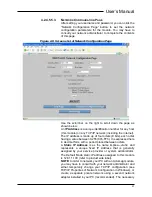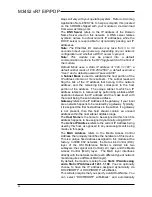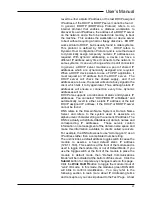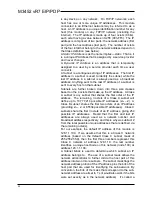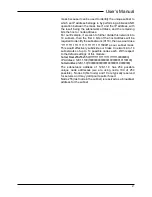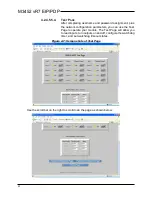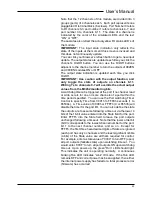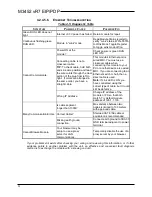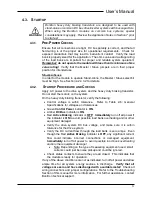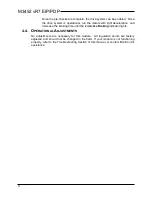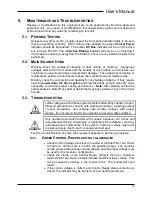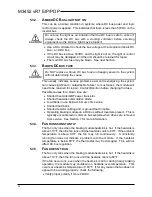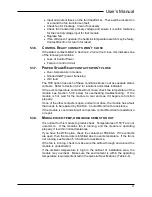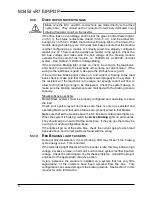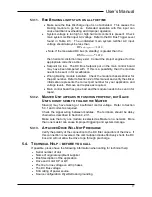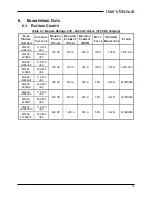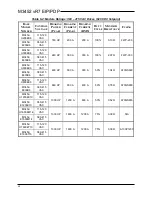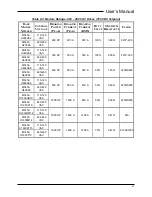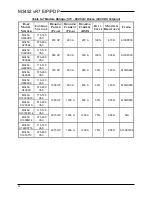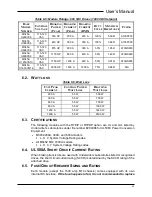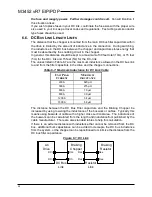
M3452 vR7 EIP/PDP
56
5.3.9.
D
RIVE TRIPS ON OVERVOLTAGE
CAUTION!
Make sure the DC+ and DC- connections are made directly to the drive
system bus. They should not be connected to terminals dedicated to an
internal transistor circuit on the inverter
.
If the drive trips on overvoltage, confirm that the green Control Power light is
on (5.3.1), the status contacts are closed (5.3.6, 5.3.7), and the amber DC
bus light is on (5.3.2). Watch the red Active Braking light on the front of the
module during a braking cycle. If it never illuminates, ensure that the module
is either configured as a master, or correctly wired to a properly configured
master (4.2.3). There must be exactly one master in the system. Check the
DC bus voltage and make sure the bus voltage at the braking module
exceeds the trip point of the module, i.e. 750VDC for a 460VAC nominal
system. See Table 2-3: DC Bus Voltage Rating.
If the red Active Braking light comes on, check the wiring to the load bank,
and check the current to the load bank with a clamp on current meter. If the
wiring to the load bank is good, make sure the DC bus fuse is good.
If the red Active Braking light comes on, and current is flowing to the load
bank, check to make sure that the module is sized properly for the system. If
the resistance of the load bank is too large, not enough current will flow to
allow for the braking energy to be dissipated. Check the system design to
make sure the braking requirements are matched with the braking module
capacity.
M
ASTER
/S
LAVE SYSTEMS
Master/Slave systems must be properly configured and operating to share
the load.
Check your system layout and make sure there is only one selected and
operating Master and that all the Slaves are properly wired to that Master.
Make sure that all the modules have the DC bus and control power lights on.
When the system is braking, watch the
Active Braking
lights on all modules.
They should all go on and off at the same time. If they do not, there may be
a wiring or module configuration issue.
If the lights all go on at the same time, check the current going to each load
bank as above and correct problems found with the wiring.
5.3.10.
R
ED
B
RAKING LIGHT FLICKERS
During motor deceleration, the red braking LED may flicker if the braking
cycle energy is low. This is normal.
If the red braking light flickers when the inverter is idle, this may indicate high
voltage, excessive noise, or harmonics on the main system rectifier input AC
voltage. Check the incoming AC line for these problems. Consult the project
engineer for the appropriate corrective action.
In rare instances, the module is installed on a system that has very little
capacitance, or the inverters have been removed from the bus. This
configuration can cause damage to the braking module. See Section 7 in this
manual for more information.
Summary of Contents for M3452
Page 14: ...M3452 vR7 EIP PDP 14 This page intentionally left blank ...
Page 19: ...User s Manual 19 Figure 3 2 Customer Connections in K9 Chassis CUSTOMER I 0 CONNECTION ...
Page 21: ...User s Manual 21 Figure 3 2 Customer Connections in M14 Chassis CUSTOMER I O CONNECTION ...
Page 24: ...M3452 vR7 EIP PDP 24 Figure 3 6 I O Hookup with R7 EIP PDP Communication ...
Page 26: ...M3452 vR7 EIP PDP 26 Figure 3 8 24VDC Power Connection ...
Page 58: ...M3452 vR7 EIP PDP 58 This page intentionally left blank ...
Page 66: ...M3452 vR7 EIP PDP 66 Figure 6 3 M3452 K9 Chassis Dimensional Outline Drawing ...
Page 68: ...M3452 vR7 EIP PDP 68 Figure 6 5 M3452 M14 Chassis Dimensional Outline Drawing ...
Page 75: ...User s Manual 75 NOTES ...
Page 76: ...M3452 vR7 EIP PDP 76 This page intentionally left blank ...
Page 77: ......
Page 78: ......
Page 79: ......


